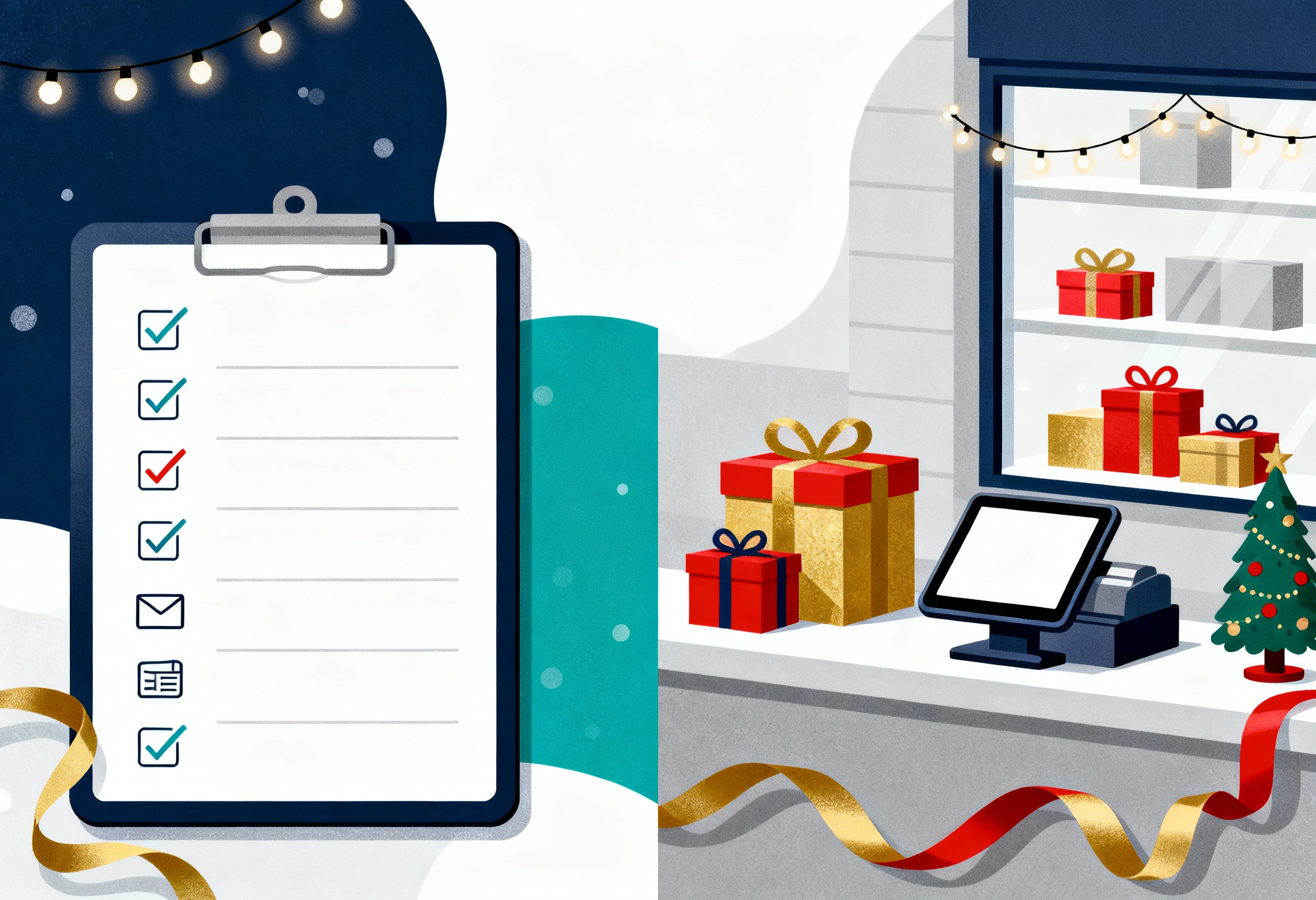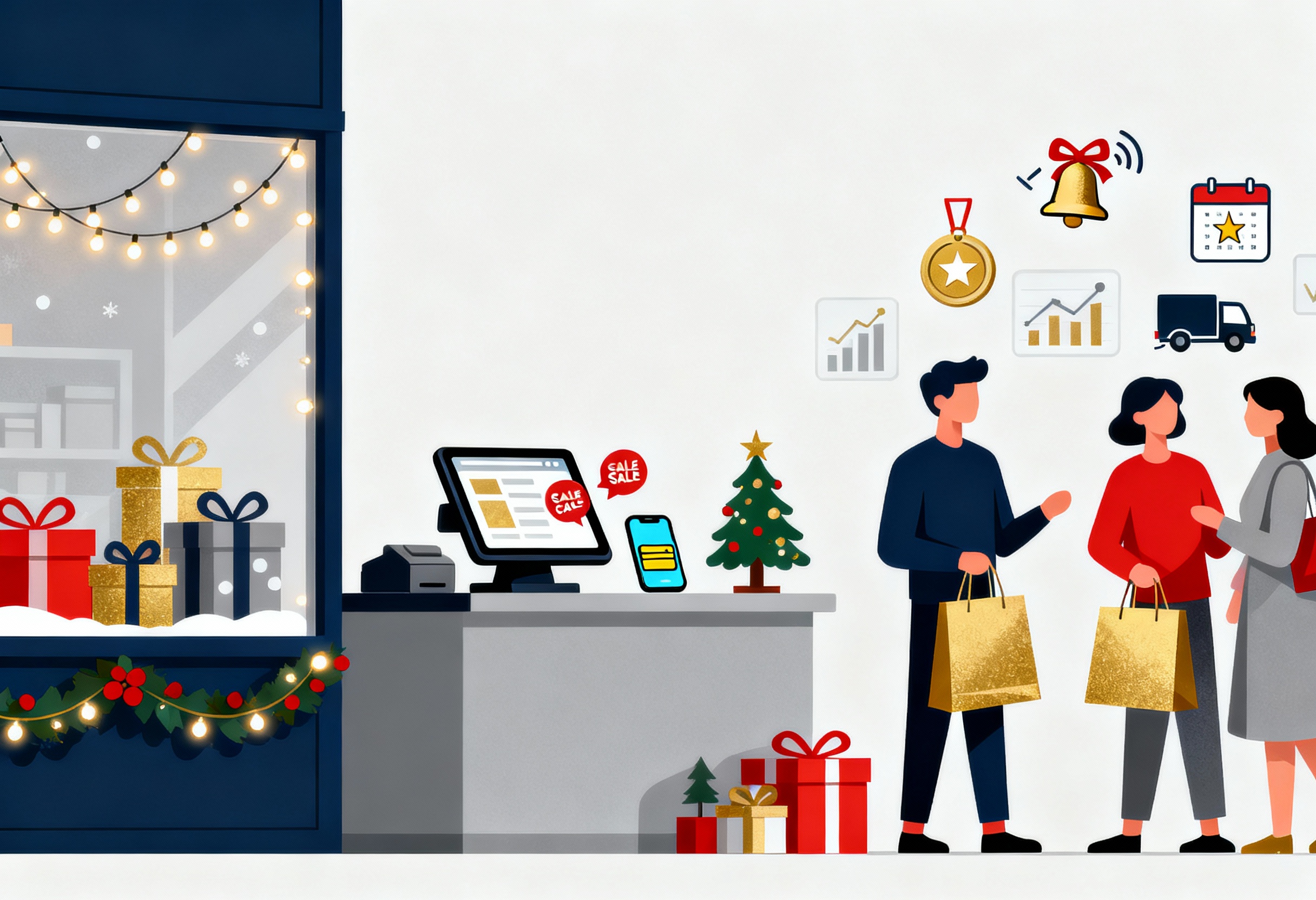Holiday shopping can overwhelm small retailers who lack the time and systems to keep up. Knowing how to prepare for holiday sales makes the difference between missed opportunities and record profits. In this guide, ConnectPOS will show practical steps, proven strategies, and smart tools to help retailers stay organized, sell more, and deliver a smoother customer experience.
Highlights
- Early preparation helps small retailers handle rising demand, stock challenges, and high customer expectations during the holiday rush.
- Smart planning across inventory, storefronts, marketing, staff, and customer experience creates smoother operations and stronger sales results.
- Tracking performance throughout the season ensures quick adjustments, keeping sales steady and customers satisfied even during peak shopping days.
Why Preparing for Holiday Sales is Important
Holiday shopping is no longer limited to December. Consumers start earlier each year, with surveys showing nearly half of shoppers begin before November, up from about 40% a decade ago. Learning how to prepare for holiday sales early gives more chances to sell, but also creates more room for mistakes if planning is rushed.
Small retailers face unique challenges. Shipping delays, staffing shortages, and unexpected surges in demand can stretch resources thin. Customers, meanwhile, have grown less patient. According to McKinsey, over 90% of U.S. online shoppers now expect free two- to three-day shipping as standard, and when delivery feels too slow, nearly half of omnichannel consumers will shop elsewhere. When a small store fails to meet those expectations, shoppers often turn to bigger brands without hesitation.
Planning ahead is what levels the playing field. Early preparation allows retailers to secure inventory before suppliers run into backlogs. It also creates space to hire and train seasonal staff, design promotions, and prepare both online and physical storefronts. Those who take action in advance not only avoid costly mistakes but also give themselves a chance to shine when customer attention is at its peak.
Looking back at previous holiday seasons is the first step to building a smarter plan for the year ahead. Now, let’s go into how to review past holidays to plan ahead.
Review Past Holidays to Plan Ahead
The smartest way to prepare for holiday sales is to learn from the past. Every season leaves behind valuable clues about what worked and what fell flat. Instead of guessing, retailers can turn last year’s performance into a guide for smarter planning this year.
Start by reviewing sales data. Which products sold out quickly? Which items gathered dust on the shelves? Identifying top performers helps decide where to allocate budget, while weak sellers reveal what to avoid or repackage differently. Some stores even create holiday bundles out of slow movers paired with best-sellers to clear stock without hurting margins.
Once the numbers are clear, forecast demand. Consider not just last year’s figures but also current shopping trends and market shifts. Adobe reported that U.S. online holiday sales reached $241.4 billion in 2024, up from $222.1 billion in 2023. Smartphones played a central role, driving 54.5% of online purchases overall and 65% on Christmas Day. These shifts highlight how digital channels, especially mobile, are shaping modern holiday shopping patterns and should guide how retailers prepare for demand.
Budget planning should come last. Allocate funds to inventory first, then set aside money for seasonal staff, packaging, and marketing campaigns. This balance prevents overspending while keeping operations flexible. A retailer who budgets wisely not only avoids panic during December but also positions themselves for steady profit throughout the season.
Now, it’s time to move from past insights to a clear checklist that helps you get holiday-ready.
►►► Optimal solution set for businesses: Multi store POS, Next-gen POS, Inventory Management Software (MSI), Self Service, Automation, Backorders
Holiday Sales Preparation Checklist for Small Retailers
The holiday season brings high expectations and fierce competition. In this checklist, we’ll show you the practical steps small retailers should follow to prepare for holiday sales.
Get Your Inventory Ready
Inventory makes or breaks the holiday season. Ordering late can lead to empty shelves, delayed shipments, and frustrated customers. The earlier stock is secured, the easier it is to meet rising demand without relying on expensive last-minute suppliers.
Focus first on proven best-sellers. Look back at previous holiday seasons and note which products consistently performed well. These items deserve extra quantities, since customers will likely return for them again. Retailers can also create holiday bundles, pairing popular items with slower movers, to raise average order value and clear old stock. Bundling also gives shoppers the feeling of receiving more value for their money.
Technology plays a key role in keeping stock under control. Real-time inventory tracking provides visibility across all channels, preventing overselling online or in-store. When shoppers see an item marked “in stock,” they need to trust that information. Reliable inventory management systems safeguard that trust and avoid order cancellations. A small gift shop using real-time tracking, for example, can keep accurate counts during busy weekends, ensuring customers never purchase items already sold out.
The cost of getting this wrong adds up. NIQ estimates out-of-stocks cost US retailers about $48 billion in a recent 12-month period.
Strengthen Storefronts – Online and Offline
Holiday shoppers judge a store within seconds. Slow websites or long checkout lines push customers away fast, so retailers must prepare for holiday sales by giving extra attention to both digital and physical storefronts.
Online stores should run fast and be easy to navigate. Mobile shoppers now account for more than half of holiday purchases, so every page must display clearly on small screens. Checkout should also be simple, requiring only essential steps to finish an order. Retailers who cut friction here see higher conversions.
Physical stores benefit from atmosphere. Festive displays, thoughtful packaging, and gift-wrapping services add to the shopping experience and encourage impulse buys. Even small touches like seasonal scents or music make the space feel inviting. Payment flexibility is the final piece. Offering cards, mobile wallets, and even gift cards ensures no customer is turned away at the register. A boutique that adds contactless payment, for instance, can keep lines moving quickly during crowded weekends.
Flexible payments are also demand-driven. Buy Now, Pay Later accounted for an estimated $18.2 billion of US online holiday spend in 2024, and BNPL purchases spiked 42.5% year-over-year on Cyber Monday 2023.
Craft a Smart Marketing & Promotion Plan
Shoppers are bombarded with deals during the holidays, so a scattered approach rarely works. Retailers need a plan that maps out campaigns in advance, hitting major dates like Black Friday, Cyber Monday, and the final shopping weeks in December. Structured promotions keep customers engaged without draining margins. Personalization can lift revenues 5–15% and increase marketing ROI 10–30%, making segmented email and on-site targeting high-leverage work for small teams.
Gift guides are a simple yet effective tool. Grouping products by price range or theme, such as “gifts under $50” or “holiday treats for kids,” helps customers decide quickly. Guides also encourage larger basket sizes since buyers often add extra items that fit the theme.
Communication ties it all together. Segmented email campaigns let retailers speak directly to different audiences, from loyal repeat buyers to new subscribers. Social media countdowns, behind-the-scenes posts, and daily highlights build excitement. A local store that teased “12 days of holiday deals” on Instagram, for example, kept followers checking back each day, turning casual browsers into steady buyers.
Prepare Staff and Operations
Holiday sales spikes test both people and processes. To prepare for holiday sales successfully, small retailers must strengthen staff readiness and operational systems well before peak demand hits.
Operational readiness matters just as much. Stocking up on packing materials and setting clear shipping cutoffs prevent last-minute chaos. Customers trust retailers who communicate deadlines up front, and that trust leads to repeat business.
During the 2024 holidays, parcel carriers were positioned to handle roughly 2.2 billion deliveries and returns between Thanksgiving and New Year’s with on-time performance near 100%. Clear, realistic cutoffs help your promises align with that network capacity
Adding loyalty perks can also ease the load. Exclusive deals for members or free shipping for higher-value orders encourage customers to shop more and complain less about delivery timelines. A toy store that gave loyalty members early access to new stock, for instance, not only increased sales but also managed crowds more effectively.
According to McKinsey, well-designed loyalty programs can boost revenue from redeeming members by 15–25% annually.
Enhance Customer Experience
The holiday rush can feel transactional, but small gestures often turn a one-time buyer into a long-term customer. Gift cards, both digital and physical, give shoppers a convenient option when they can’t decide on the right item. They also extend sales beyond December as recipients return to redeem them.
Clarity is another part of the customer experience. Transparent shipping timelines and straightforward return policies reduce complaints and keep customer service from being overwhelmed. Nobody wants to argue about unclear cutoff dates right before Christmas. Retailers projected $148 billion in holiday returns in 2023, with an average return rate of 15.4%.
Adding personal touches seals the memory. A short thank-you note, festive packaging, or complimentary gift wrapping creates a sense of care. One boutique that slipped handwritten notes into each package saw customers sharing photos online, effectively turning a small act into free word-of-mouth marketing.
Adjust Your Plan Throughout the Season
When you prepare for holiday sales, the work doesn’t stop once sales begin. Staying flexible and ready to shift ensures retailers keep up with changing demand and customer behavior. A plan that adapts in real time is far stronger than one that stays fixed.
- Track key performance metrics with report & analytics. Monitor sales, conversion rates, and the success of promotions daily. This shows which campaigns to expand and which to drop.
- Watch stock levels closely. Demand often spikes without warning. Reordering fast-moving products quickly keeps shelves filled and avoids missed revenue.
- Be ready for post-holiday returns. Clear policies, extra staff, and efficient processes turn what could be a headache into an opportunity to build trust.
- Learn from unexpected trends. Sometimes a small promotion or product gains traction unexpectedly. Spotting these patterns early helps capture extra sales.
Staying alert throughout the season lets small retailers act quickly instead of reacting late. The businesses that review numbers daily, restock without delay, and manage returns smoothly finish the season stronger and more profitable.
Preparing for Holiday Sales with ConnectPOS
The holiday season pushes retailers harder than any other time of year. Inventory needs to stay accurate, checkout lines must move quickly, and customers expect flexible service across channels. ConnectPOS equips small retailers with tools that handle the chaos while creating a smoother experience for shoppers.
- Real-time inventory sync keeps stock accurate across online and in-store channels, cutting the risk of overselling during busy weekends.
- Multi-store and multi-warehouse management shows live stock levels and supports quick transfers between locations when one store runs low.
- Offline mode secures sales by keeping transactions active even if internet service drops.
- Mobile POS allows retailers to set up seasonal pop-ups, bust long lines, and support flexible holiday staffing.
- Advanced self-checkout shortens waiting times and improves customer flow in crowded stores.
- Flexible payment options include cards, mobile wallets, gift cards, and loyalty points so shoppers can pay however they prefer.
- Bulk order handling and B2B checkout logic serve wholesalers and small retailers managing larger orders during seasonal peaks.
- Customer loyalty and membership programs reward buyers with points, tiers, seasonal discounts, or early access to holiday sales.
- Gift cards and vouchers attract new customers and make popular gift choices for last-minute shoppers.
- Click & collect support lets customers buy online and pick up in-store with minimal friction.
- Custom promotions and discount rules simplify the setup of Black Friday, Cyber Monday, and other holiday campaigns, with powerful automation available when you need it.
- Comprehensive analytics and reporting track sales spikes, best-sellers, and staff performance in real time.
- Seamless integration with Shopify, Magento, BigCommerce, WooCommerce, Commercetools, and NetSuite keeps every sales channel connected.
These tools help small retailers meet heavy holiday demand with confidence. ConnectPOS makes sure products are available, lines are short, and customers leave happy.
FAQs: Prepare for Holiday Sales
1. When should a small retailer start to prepare for holiday sales?
Begin planning in early Q4, ideally by October. Secure stock, schedule promotions, and set staffing needs early to avoid last-minute stress.
2. How much inventory should we stock for the holidays?
Use last year’s sales as a baseline. Add trending items, build a small buffer, and reorder fast movers weekly to prevent missed opportunities.
3. What promotions work best for small stores?
Seasonal bundles, tiered discounts, gift-with-purchase, and free shipping thresholds often drive sales. Structure promotions carefully to maintain healthy margins while attracting loyal shoppers.
4. How do we handle shipping cutoffs and returns?
Communicate cutoff dates clearly online, in emails, and at checkout. Keep returns transparent, time-bound, and simple to manage while maintaining customer trust.
5. What can we do to speed checkout and cut lines?
Enable tap-to-pay, provide flexible payment methods, and use mobile POS to manage high-traffic periods, keeping checkout lines short and customer satisfaction high.
6. We sell online and in-store. How do we keep stock accurate across both?
Operate with a single unified system. ConnectPOS syncs stock across all channels in real time, preventing overselling and ensuring accurate availability for shoppers.
7. What should we track during the season?
Monitor daily sales, conversion rates, order value, top SKUs, return volumes, and promotional lift. Adjust quickly to trends to maintain strong performance.
Final Thoughts
To truly prepare for holiday sales, retailers need more than stocked shelves and eye-catching ads. Small businesses must rely on strong systems that manage demand, keep checkout lines short, and deliver reliable service. ConnectPOS ties all of these needs together in one platform.
Through adopting tools that sync inventory, simplify payments, and support personalized promotions, retailers can meet the season head-on. Shoppers get a smooth experience, and businesses capture more sales without added stress. This holiday season, prepare smarter and let ConnectPOS handle the heavy lifting. Ready to gear up for the busiest time of the year? Contact us today and see how ConnectPOS can prepare your store for holiday sales success.
►►► Optimal solution set for businesses: Shopify POS, Magento POS, BigCommerce POS, WooCommerce POS, NetSuite POS, E-Commerce POS



